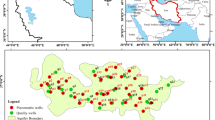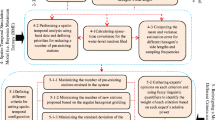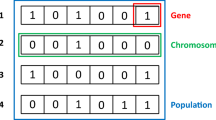Abstract
A new approach is presented based on the entropy theory to design an optimal groundwater quality monitoring network. First, the unrecorded values of Total Dissolved Solids (TDS) are estimated in the study area using Artificial Neural Network (ANN) and K-Nearest Neighbor (KNN) methods, and then, using Differential Evolution (DE) optimization algorithm aimed at maximizing the pure information gained by stations. The number and location of monitoring stations are selected optimally from the active wells located in the study area. The spatial distribution of chosen wells provides adequate coverage of the whole aquifer and, at the same time, gives the maximum useful information about the water quality status. It also avoids selecting any redundant station considering the operational and temporal costs. The proposed entropy method is compared with “error minimization” and “K-Means clustering” methods and is shown to be superior. The proposed approach is used for optimizing Eshtehard aquifer monitoring network in central part of Iran. As a result of its implementation, 20 wells are selected among 79 active monitoring wells in the study area, so that by sampling the wells, the maximum qualitative information can be obtained without needing to sample all the wells.









Similar content being viewed by others
References
Alfonso L (2010) Optimisation of monitoring networks for water systems, information theory, value of information and public participation. PhD thesis, Delft University of Technology, Delft, The Netherlands
Alizadeh Z, Mahjouri N (2017) A spatiotemporal Bayesian maximum entropy-based methodology for dealing with sparse data in revising groundwater quality monitoring networks: the Tehran region experience. Environ Earth Sci 76:436
Ayvaz MT, Elçi A (2018) Identification of the optimum groundwater quality monitoring network using a genetic algorithm based optimization approach. J Hydrol 563:1078–1091
Barca E, Pasarella G, Vurro M, Morea A (2015) MSANOS: data-driven, multi-approach software for optimal redesign of environmental monitoring networks. Water Resour Manag 29:619–644
Bhat S, Motz LH, Pathak C, Kuebler L (2015) Geostatistics-based groundwater-level monitoring network design and its application to the upper Floridan aquifer, USA. Environ Monit Assess 187:4183
Boltzmann L (1877) Uber die Beziehung zwischen dem zweiten Hauptsatze der mechanischen Warmetheorie und der Wahrscheinlichkeitsrechnung respektive den Satzen uber das Warmgleichgewicht. Weiner Berichte 76:373–435
Bruno DE, Barca E, Goncalves RM, Queiroz HA, Berardi L, Passarella G (2018) Linear and evolutionary polynomial regression models to forecast coastal dynamics: comparison and reliability assessment. Geomorphology 300:128–140
Datta B, Singh D (2014) Optimal groundwater monitoring network design for pollution plume estimation with active sources. Int J of Geomate 6:864869
Deb K, Anand A, Joshi D (2002) A computationally efficient evolutionary algorithm for real-parameter optimization. Evol Comput 10(4):371–395
Esquivel JM, Morales GP, Esteller MV (2015) Groundwater monitoring network design using GIS and multicriteria analysis. Water Resour Manag 29:3175–3194
Hegerty B, Hung C, Kasprak K (2009) A comparative study on differential evolution and genetic algorithms for some combinatorial problems. 8th Mexican International Conference on Artificial Intelligence
Hengl T, Heuvelink GBM, Stein A (2004) A generic framework for spatial prediction of soil variables based on regression-kriging. Geoderma 120:75–93
Hosseini M, Kerachian R (2017) A data fusion-based methodology for optimal redesign of groundwater monitoring networks. J Hydrol 552:267–282
Keum J, Kornelsen K, Leach J, Coulibaly P (2017) Entropy applications to water monitoring network design: a review. Entropy 19(11):613
Kraskov A, Stögbauer H, Andrzejak RG, Grassberger P (2005) Hierarchical clustering using mutual information. Europhys Lett 70(2):278–284
Mahjouri N, Kerachian R (2011) Revising river water quality monitoring networks using discrete entropy theory: the Jajrood River experience. Environ Monit Assess 175:291–302
Masoumi F, Kerachian R (2010) Optimal redesign of groundwater quality monitoring networks: a case study. Environ Monit Assess 161:247–257
Maymandi N, Kerachian R, Nikoo MR (2018) Optimal spatio-temporal design of water quality monitoring networks for reservoirs: application of the concept of value of information. J Hydrol 558:328–340
Memarzadeh M, Mahjouri N, Kerachian R (2013) Evaluating sampling locations in river water quality monitoring networks: application of dynamic factor analysis and discrete entropy theory. Environ Earth Sci 70:6
Nunes LM, Paralta E, Cunha MC, Ribeiro L (2004) Ground-water nitrate monitoring network optimization with missing data. Water Resour Res 40(2):1–18
Owlia RR, Abrishamchi A, Tajrishy M (2011) Spatial–temporal assessment and redesign of groundwater quality monitoring network: a case study. Environ Monit Assess 172:263–273
Pourshahabi S, Talebbeydokhti N, Rakhshandehroo G, Nikoo MR (2018) Spatio-temporal multi-criteria optimization of reservoir water quality monitoring network using value of information and transinformation entropy. Water Resour Manag 32:3489–3504
Ran Y, Li X, Ge Y, Lu X, Lian Y (2015) Optimal selection of groundwater-level monitoring sites in the Zhangye Basin, Northwest China. J Hydrol 525:209–215
Reed P, Minsker BS (2004) Striking the balance: long-term groundwater monitoring design for conflicting objectives. J Water Resour Plan Manag 130(2):140–149
Shannon CE (1948) A mathematical theory of communications. Bell Syst Tech J 27:379–423
Singh S, Krishan G, Ghosh NC, Jaiswal RK, Thomas T, Nayak TR (2018) Identification and planning of water quality monitoring network in context of integrated water resource management (IWRM). Environ Pollut 77:513–524
Storn R, Price KV (1995) Differential evolution – a simple and efficient adaptive scheme for global optimization over continuous spaces. Technical Report TR-95-012, ICSI
Storn R, Price K (1997) Differential evolution – a simple and efficient heuristic for global optimization over continuous spaces. J Glob Optim 11:341–359
Triki I, Zairi M, Dhia HB (2012) A geostatistical approach for groundwater head monitoring, network optimisation: case of the Sfax superficial aquifer (Tunisia). Water Environ J 27:362
Woldt W, Bogardi I (1992) Ground water monitoring network design using multiple criteria decision making and geostatistics. Water Resour Bull 28(1):45–62
Yazdi J (2016) Decomposition based multiobjective evolutionary algorithms for design of large-scale water distribution networks. Water Resour Manag 30:2479
Yazdi J, Yoo DG, Kim JH (2016) Comparative study of multi-objective evolutionary algorithms for hydraulic rehabilitation of urban drainage networks. Urban Water J 14(5):483–492
Zhou Y, Dong D, Liu J, Li W (2013) Upgrading a regional groundwater level monitoring network for Beijing plain, China. Geosci Front 4:127–138
Author information
Authors and Affiliations
Corresponding author
Rights and permissions
About this article
Cite this article
Alizadeh, Z., Yazdi, J. & Moridi, A. Development of an Entropy Method for Groundwater Quality Monitoring Network Design. Environ. Process. 5, 769–788 (2018). https://doi.org/10.1007/s40710-018-0335-2
Received:
Accepted:
Published:
Issue Date:
DOI: https://doi.org/10.1007/s40710-018-0335-2




